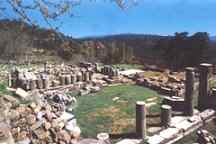 Labranda, which is the holy area of Zeus Labraundeus, is in ancient Caria (Southwestern Anatolia), 13 kilometers (8 miles) northeast of Milas (ancient Mylasa), the city to which it is affiliated. The site is famous with its Temple of Zeus, its delicious water, and its pine and plane tree forests. There are daily tours to Labranda from Bodrum as well which is about 1 hour away.
Labranda, which is the holy area of Zeus Labraundeus, is in ancient Caria (Southwestern Anatolia), 13 kilometers (8 miles) northeast of Milas (ancient Mylasa), the city to which it is affiliated. The site is famous with its Temple of Zeus, its delicious water, and its pine and plane tree forests. There are daily tours to Labranda from Bodrum as well which is about 1 hour away.
The most ancient findings belong to the year 600 BC. The site has been used as holy area in 6th and 5th centuries BC and then as a temple consisted of a single, small, artificial terrace. A war took place in the holy area in 497 BC and Carian army has been defeated by the Persians with its allies.
The temple of Zeus is the most important relic of the ancient site, built around 4th century BC. Its dimensions are 25 x 16 meters (82 x 52 feet) with 6 x 11 meters (20 x 36 feet) of one row of columns with Attica.
Under the rule of two Persian satraps named Mausolos (377-352 BC) and Idrieus (351-344 BC), this site gained a new appearance. During a sacrifice festival in Labranda in 355 BC, Mausolos escaped from an assassination at last moment. Buildings here are like a series of artificial terraces; one or two entrance buildings, a small Doric building (probably a fountain), monumental stairs, two large feast halls (Androns), shed building (named as Oikoi), Stoa and Zeus Temple surrounded with columns are probabily constructed after this event. The constructions of such works have been stopped after the death of Idrieus in 344 BC. After a big fire that took place in the 4th century BC, the holy area has lost its feature of being a cult place and then abandoned.
The excavation works at Labranda site have been started in 1948 and are continuing with intervals since that time by archaeologists of Bordeaux University in France. The access from Mylasa to the holy area had been provided via the holy road having a width of 8 meters (26 feet), which was used for religious processions. Today, only the remainings of the Sacred Road can be seen. The laying traces on this road can be seen even today. Access to the area was provided with one of the two entrance gates (Propylon). These monumental passage buildings were impressive and made of Milas marble, having two columns and Ionian frontals on each side.
The building called as "Doric building" was located to the east of the southern propylon building with its irregular formation close to a rectangle. The building was turned towards north, had four columns, a front courtyard, a marble side and was in Doric style. Most probabily it had the function of a fountain building. This small building has been included in the bath complex.
200 meters (219 yards) west of the holy building, lies the stadium whose back side is reinforced with a retaining wall. It is 176 meters (192 yards) long and the starting and end stones of the competitions are still standing at both ends. It is supposed that some competitions were made here during the feast of 5 days made in the holy area.

